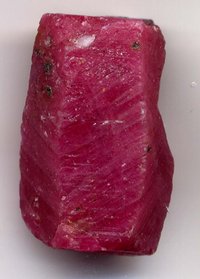Ruby
|
|
| Ruby | |
|---|---|
| General | |
| Category | Mineral |
| Chemical formula | aluminium oxide, Al2O3 |
| Identification | |
| Color | Red, may be brownish |
| Crystal habit | Varies with locality. Terminated tabular hexagonal prisms. |
| Crystal system | Trigonal |
| Cleavage | No true cleavage |
| Fracture | Uneven or conchoidal |
| Mohs Scale hardness | 9.0 |
| Luster | Vitreous |
| Refractive index | ~1.77 |
| Pleochroism | ? |
| Streak | white |
| Specific gravity | 4.0 |
| Fusibility | ? |
| Solubility | ? |
| Major varieties | |
| Corundum | Ruby when uncontaminated with chromium |
Ruby is a red gemstone, a variety of the mineral corundum in which the color is caused mainly by chromium. Its name originates from ruber, Latin for red. Natural rubies are exceptionally rare, though artificial ones (sometimes called created ruby) can be manufactured which are comparatively inexpensive.
Rubies are mined in Africa, Asia and Australia. They are most often found in Myanmar, Sri Lanka and Thailand, though they have also been found in Montana and South Carolina. Sometimes spinels are found along with rubies in the same geological formations and are mistaken for the more valuable gem. However, fine red spinels may approach the average ruby in value.
Rubies have a hardness of 9 on the Mohs scale of mineral hardness, and among the natural gems are only surpassed by diamonds in hardness. Other varieties of corundum are called sapphires.
Cut_Ruby.jpg
A synthetic ruby crystal was used to create the first laser.
Ruby is the birthstone associated with July.
The world's biggest star ruby is the Rajaratna Ruby, which weighs 2,475 carats (495 g). The world's biggest double-star ruby (with a 12-pointed star) is the Neelanjali Ruby, weighing 1,370 carats (274 g). Both rubies currently belong to G. Vidyaraj from Bangalore in India.
See also
da:Rubin de:Rubin et:Rubiin eo:Ruby fr:rubis ja:ルビー nl:Robijn pl:Rubin pt:Rubi sv:Rubin vi:Hồng ngọc zh-tw:红宝石

